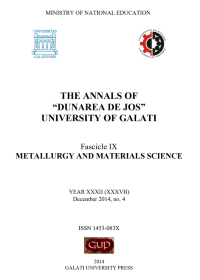Experiments on Ballistic Tests for Improving Performance of a Neutralizing Gas Dynamics System
Abstract
Neutralizing improvised explosive devices (handmade) by mechanical separation of the elements which are part of their composition can be achieved by the following methods:
- generation of shock waves by means of the impact method between a projectile or a jet formed from diverse disrupting backgrounds and the improvised explosive device. It is known that after impact we must have at the interface projectile (jet)–target the same pressure and material speed; they characterize the equilibrium that is established at the interface;
- generation of shock waves by detonating explosives placed in direct contact with parts subject to shock. This method is destructive and it must take into account the combined effects of explosive load that we want to neutralize and cargo of explosives used in neutralization; it can be used only in special places which can provide a range of effective safety;
- generation of shock waves using lasers; at this stage, this method is only used in laboratories through fundamental research.
The most used method for neutralization of an improvised explosive device is the first one. The neutralization systems (gas-dynamics systems) that propel the kinetic projectiles using explosives are used to transmit large shocks to various inert or reactive targets. These shocks have a significant impact on the targets, transmit changes in state and kinematic parameters, leading to either dismantling of targets or initiating explosive charges receivers. Initiating the explosive to the receiver detonation devices that can be parts of improvised explosive devices happens because the incident shock wave has exceeded the critical threshold of initiation. The initiation of detonation is, generally, an undesirable event, as explosive charge mass, although part of it, may not make it possible to take appropriate safety distances and thus material damage and human injury can be induced.
Given the complexity of improvised explosive devices, the impossibility of knowing the exact explosive charges and the initiation ones in their composition, we cannot say that there existsa neutralizing thruster jet to meet all technical requirements specified above. In an attempt to simplify and systematize the study, we are going to present a summary classification of explosive jet engines means, capable of being used to neutralize improvised explosive devices.
Downloads
References
[2]. Kinney, G.F., Graham, K.I., Explosive Shocks in air, Second Edition Poringer–Verlag Berlin Heidelberg, New York Tokyo, 1985.
[3]. Kistiakovsky, G. B., Wilson E. B., Teoria hidrodinamică a detonaţiei şi undele de şoc, Report 114,1941.
[4]. Thevenin, M., Metode moderne în pirotehnie şi detonică, Paris, 1972.
[5]. Voicu V., Sisteme clasice pentru neutralizarea dispozitivelor explozive artizanale utilizate de specialişti din alte ţări, a XIX – a Sesiune de Comunicări Ştiinţifice cu participare internaţională „NAV – MAR – EDU 2005”, Constanţa, 2005.
[6]. Voicu V., Studiul dispozitivelor explozive artizanale şi al mijloacelor de neutralizare a acestora, Referat 3, Academia Tehnică militară, Bucureşti, 2002.
[7]. Voicu V., Studiul teoretic şi experimental al propulsiei jeturilor de neutralizare prin deflagraţia pulberilor, Bucureşti, Revista Tehnică Militară nr. 2, 2004.
[8]. ***, http://www.internationalindustries.net/Proparms/index.htm.
[9]. ***, http://www.antennasystems.com/disrupters/0201102.html.
[10]. ***, http://www.proparms.com/site/product_6.html.
[11]. ***, http://www.nrm.qld.gov.au/mines/explosives/incidents, html.
[12]. ***, http://www.fbi.gov/publications/terror.



